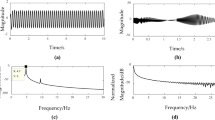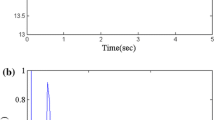Abstract
The squirrel cage induction motor is considered to be one of the most important types of motors used in industries. An unexpected failure can lead to unwanted downtime and heavy financial losses to the industries regarding maintenance cost and profits. This paper deals with the problem of broken rotor bars fault diagnosis in saturated induction motor. Several techniques such as those based on vibration, axial leakage monitoring, zero-sequence component, negative sequence current, and motor current signature analysis have been used. However, these techniques do not take into account the effect of magnetic saturation. This paper presents a current Park’s Vector method for diagnosis in squirrel cage induction motor with the presence of magnetic saturation. The use of a current vector pattern demonstrates that deformation of the Current Park’s Vector Pattern trajectory and increasing diameter are indicators for predicting magnetic saturation and broken bars rotor fault. Our experimental results allow us to discriminate between the magnetic saturation in healthy and faulty squirrel cage induction motors.

















Similar content being viewed by others
References
Seong HI, Bon GG (2022) Study of induction motor inter-turn fault part II: online model based fault diagnosis method. Energies 15:977. https://doi.org/10.3390/en15030977
Ahmed R (2021) Faults diagnosis in stator windings of high speed solid rotor induction motors using fuzzy neural network. Int J Power Electron Drive Syst 12(1):597–611. https://doi.org/10.11591/ijpeds.v12.i1.pp597-611
Biswarup G, Arpan C, Arunava C et al (2020) Diagnosis of stator winding fault of single-phase induction motor employing wavelet induced residual-convolutional neural network. In: IEEE International conference on power electronics, drives and energy system (PEDES), 16–19 Dec 2020. https://doi.org/10.1109/PEDES49360.2020.9379665
Mohammed SJB, Jassim MH (2019) Inter-turn stator winding faults diagnosis in three-phase induction motor fed from imbalanced voltage source. J Eng Appl Sci. https://doi.org/10.36478/jeasci.2019.7591.7598
Reljic D, Jerkan D (2016) Broken bar fault detection in IM operating under no-load condition. Adv Electr Comput Eng 16(4):63–70. https://doi.org/10.4316/AECE.2016.04010
Zolfaghari S, Noor SBM, Mehrjou MR, Marhaban MH, Mariun N (2017) Broken rotor bar fault detection and classification using wavelet packet signature analysis based on Fourier transform and multi-layer perceptron neural network. Appl Sci 8:25
Edomwandekhoe K, Liang X (2018) Advanced feature selection for broken rotor bar faults in induction motors. In: Proceedings of 2018 IEEE/IAS 54th industrial and commercial power systems technical conference (I&CPS), pp 1–10, May 2018.
Wang Z, Yang J, Li H, Zhen D, Xu Y, Gu F (2019) Fault identification of broken rotor bars in induction motors using an improved cyclic modulation spectral analysis. Energies 12(17):3279
Zijian L, Pinjia Z, Shan H, Jin H (2021) A review of modeling and diagnostic techniques for eccentricity fault in electric machines. Energies 14:4296. https://doi.org/10.3390/en14144296
Faiz J, Ghods M, Tajdyni A (2019) Dynamic air gap asymmetry fault detection in single-sided linear induction motors. IET Electr Power Appl 14:605–613
Wagner FG, Daniel MS, Oscar DP et al (2020) Estimation of bearing fault severity in line-connected and inverter-fed three-phase induction motors. Energies 13(13):3481. https://doi.org/10.3390/en13133481
Guoping A, Qingbin T, Yanan Z et al (2021) An improved variational mode decomposition and its application on fault feature extraction of rolling element bearing. Energies 14(4):1079. https://doi.org/10.3390/en14041079
Nemec M, Ambrožič V, Fišer R, Nedeljković D, Drobnič K (2019) Induction motor broken rotor bar detection based on rotor flux angle monitoring. Energies 12:794
Dias CG, da Silva LC, Luz Alves WAA (2020) Histogram of oriented gradients approach for detecting broken bars in squirrel-cage induction motors. IEEE Trans Instrum Meas 69:6968–6981
Fernandez-Cavero V, Pons-Llinares J, Duque-Perez O, Morinigo-SOTELO D (2021) Detection of broken rotor bars in non-linear startups of inverter-fed induction motors. IEEE Trans Ind Appl 57:2559–2568
Li H, Feng G, Zhen D, Gu F, Ball AD (2021) A normalized frequency-domai energy operator for broken rotor bar fault diagnosis. IEEE Trans Instrum Meas. https://doi.org/10.1109/TIM.2020.3009011
Noman S, Lauri K, Bilal A, Muhammad J et al (2001) Spectrum analysis for condition monitoring and fault diagnosis of ventilation motor: a case study. Energies 2021:14. https://doi.org/10.3390/en14072001
Park YS (2020) Investigation on electromagnetic performance of induction motor with rotor bar faults considering motor current signals. Adv Electr Comput Eng 20(4):37–40. https://doi.org/10.4316/AECE.2020.04005
Ojeda-Aguirre NA, Garcia-Perez A et al (2019) Reassigned short time fourier transform and k-means method for diagnosis of broken rotor bar detection in vsd-fed induction motors. Adv Electr Comput Eng 19:61–68. https://doi.org/10.4316/AECE.2019.02008
Bessous N, Sbaa S, Megherbi AC (2019) Mechanical fault detection in rotating electrical machines using MCSA-FFT and MCSA-DWT techniques. Bull Pol Acad Sci Tech Sci 67(3):571–582. https://doi.org/10.24425/bpasts.2019.129655
Matic D, Kanovic Z (2017) Vibration based broken bar detection in induction machine for low load conditions. Adv Electr Comput Eng 17:63–70. https://doi.org/10.4316/AECE.2017.01007
Mustapha M, Aymen F, Abdullah AA et al (2022) Diagnosis and fault detection of rotor bars in squirrel cage induction motors using combined Park’s vector and extended Park’s vector approaches. Electronics 11:380. https://doi.org/10.3390/electronics11030380
Shurong W, Xin Z, Yao X, Yang F, Zixu R, Fangxing L (2020) Extended Park’s vector method in early inter-turn short circuit fault detection for the stator windings of offshore wind doubly-fed induction generators. IET Gener Transm Distrib 14(18):3905–3912. https://doi.org/10.1049/iet-gtd.2020.0127
Fatima H, Jeevan S et al (2020) Inter-turn fault diagnosis of induction motor fed by PCC-VSI using park vector approach. In: 2020 IEEE international conference on power electronics, drives and energy systems (PEDES), 16–19 Dec 2020. https://doi.org/10.1109/PEDES49360.2020.9379388
Gyftakis KN, Cardoso AJM, Daviu JAA (2017) Introducing the filtered Park’s and filtered extended Park’s vector approach to detect broken rotor bars in IM. Mech Syst Signal Proc 93:30–50
Tushar GV, Makarand BS, Hiralal SM (2017) Application of multiple parks vector approach for detection of multiple faults in induction motors. J Power Electron 17(4):97982. https://doi.org/10.6113/JPE.2017.17.4.972
Izzet Yilmaz ON, Mohamed B (2008) Induction motor bearing failure detection and diagnosis: Park and Concordia transform approaches comparative study. IEEE/ASME Trans Mechatron 13(2):257–262
Marques Cardoso AJ (1999) Inter-turn stator winding fault diagnosis in three-phase induction motors, by Park’s vector approach. IEEE Trans Energy Convers 14:595–598
Nejjari H, Benbouzid MH (2000) Monitoring and diagnosis of induction motor faults using current parks vector approach. IEEE Trans Ind Appl 36(3):730–735
Cruz SMA (2000) Stator winding fault diagnosis in three-phase synchronous and asynchronous motors, by the extended Park’s vector approach. IEEE Conf Ind Appl 1:395–401
Jasmin P, Saranya R, Indragandhi V et al (2022) 2D finite element analysis of asynchronous machine influenced under power quality perturbations. Comput Mater Contin. https://doi.org/10.32604/cmc.2022.020093
Arkadiusz D, Piotr D (2020) Induction motor fault diagnosis based on zero-sequence current analysis. Energies 13:6528. https://doi.org/10.3390/en13246528
Mehrdad G, Om-Kolsoom S, Hadi T (2021) An extended winding function model for induction machine modelling considering saturation effect. IET Electr Power Appl 15:79–91. https://doi.org/10.1049/elp2.12006
Chaouch A, Bendiabdellah A (2013) Spectral analysis to detect mixed eccentricity fault in saturated squirrel cage induction motor. In: Proceedings of the IEEE, ISPCC' 2013, India
Author information
Authors and Affiliations
Corresponding author
Additional information
Publisher's Note
Springer Nature remains neutral with regard to jurisdictional claims in published maps and institutional affiliations.
Rights and permissions
Springer Nature or its licensor (e.g. a society or other partner) holds exclusive rights to this article under a publishing agreement with the author(s) or other rightsholder(s); author self-archiving of the accepted manuscript version of this article is solely governed by the terms of such publishing agreement and applicable law.
About this article
Cite this article
Abdellah, C., Mama, C., Meflah Abderrahmane, M. et al. Current Park’s Vector Pattern Technique for Diagnosis of Broken Rotor Bars Fault in Saturated Induction Motor. J. Electr. Eng. Technol. 18, 2749–2758 (2023). https://doi.org/10.1007/s42835-022-01342-6
Received:
Revised:
Accepted:
Published:
Issue Date:
DOI: https://doi.org/10.1007/s42835-022-01342-6




